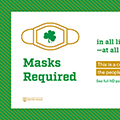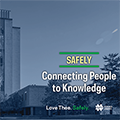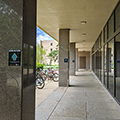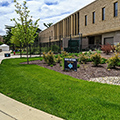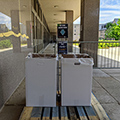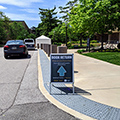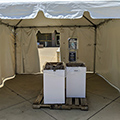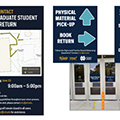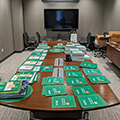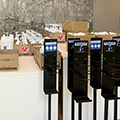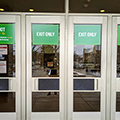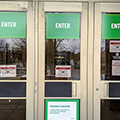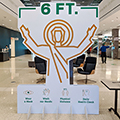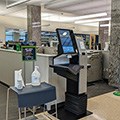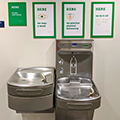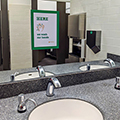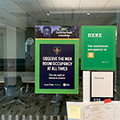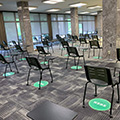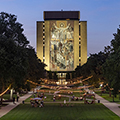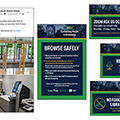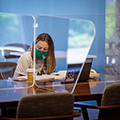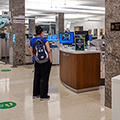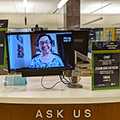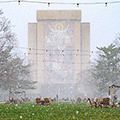COVID-19 Pandemic

MILESTONE 56 — On March 11, 2020, the Office of the President sent a campus-wide message about the University’s coronavirus response plan, stressing that the highest priority was to safeguard the health of the Notre Dame community and our neighbors while doing everything possible to continue our central work of education and research.
During the initial days and weeks, several immediate actions were taken by the University:
- Classes were suspended the week of March 15 to allow time to pivot to online instruction.
- All University-sponsored study abroad programs were suspended; students and U.S.-based faculty and staff returned home.
- As Spring Break concluded, students were strongly encouraged to stay home or return home rather than return to campus.
- Undergraduate residence halls were closed at noon on Tuesday, March 17, and all non-essential personnel were directed to work from home until further notice.
- All in-person classes were suspended from March 23 until April 13 and were replaced with virtual instruction and other alternative learning options. Ultimately, remote instruction persisted through the end of the spring term.
- The University soon enforced a staff hiring freeze.
Hesburgh Libraries COVID-19 response plan begins
From 2020 to 2022, nearly every aspect of library services and spaces were reengineered and reconfigured in response to the COVID-19 pandemic. It is impossible to feature every aspect of operational complexity, but the following highlights demonstrate the breadth and depth of our commitment to health, safety, and service excellence.
In alignment with University policies and messaging, the Hesburgh Libraries embarked on an unprecedented crisis response plan to protect the health and wellness of our community, enable continued teaching and research, and ensure instructional continuity for our students.
The north and south entrances of the Hesburgh Library were closed, and the east and west entrances were changed to ID card access only.
While many faculty and staff could perform core work functions from home, several heroic library community members remained onsite, often working in shifts, to provide seamless support for the service desks, stacks, online Course Reserves, Interlibrary Loan, Document Delivery, and more.
On Thursday, March 18, we paused borrowing books through Interlibrary Loan and began purchasing materials required for classes in electronic format. In addition, document delivery scans for chapters and articles were opened to all students in addition to faculty.
Together, the library community worked to provide support where possible via virtual access to expertise, online resources, and remote services in support of teaching and learning. Users could visit a service continuity webpage for daily updates and contact their subject librarians and liaisons for virtual consultations.
Hesburgh Library and all branch libraries close to users
The Indiana Governor issued a Stay at Home Order on March 25, 2020, that lasted until May 1. On Friday, March 27, at 5:00 p.m., all Hesburgh Libraries locations were closed to users until further notice. On March 30, Edward H. Arnold University Librarian Diane Parr Walker published a letter to the Notre Dame community.
“I assure you that, while our physical library spaces will remain important in the future, we now stand ready to offer advanced research expertise, digital materials, and innovative services in the virtual realm. Online and digital resources are available 24/7, and our subject librarians and service teams are just an email or Zoom consultation away, no matter where around the world you may be.”
Following the building and mailroom closures, the Hesburgh Libraries suspended circulation of all print materials, book returns, print material recalls, and Interlibrary Loan lending. Reserves and document delivery processes shifted to identifying digital versions or equivalents for all requested items, enlisting the help of the subject librarians as needed. This adjustment meant that staff would only need to be onsite to scan course reserve items from the physical collection when all other options had been exhausted.
The faculty and staff quickly shifted to online chat, Zoom consultations, virtual workshops, and online library instruction. Electronic Course Reserves requests were fulfilled, and every effort was made to provide access to resources and materials electronically, including resources by subject and research and course guides. To assist with remote learning, library faculty curated a list of free or expanded content offered by various academic publishers. In some cases, the Hesburgh Libraries added special links directly to our discovery system to help streamline user access and experience.
While expertise, services, and resources remained accessible virtually, the Hesburgh Library and branch library spaces remained closed to patrons until August 3.Phased reopening plans and select service expansion begin June 15
Once the State of Indiana Stay at Home Order was lifted, additional faculty and staff were allowed into the Hesburgh Library to assist with conducting essential business. On May 7, the Hesburgh Libraries Phased Reopening Task Force was formed—the reimagining and reengineering of the day-to-day processes to protect the health of our community, enable continued research, and ensure instructional continuity continued.
On June 15, Diane Parr Walker published a letter to the University community about what to expect during the phased reopening. “During the mid-summer timeframe, as we prepare for the fall semester, library building access will remain limited. With the guidance and resources of the University, we are developing plans for significant, new procedures, workflows, and required training to enable us to support on-campus teaching and research operations.”
To help facilitate undergraduate student move-out and year-end book returns, library teams created a book return process, including a three-day book quarantine procedure to ensure safe material handling. Thanks to socially distanced, well-mapped routes, the library processed approximately 5,000 items, averaging 52 daily drop-offs and 23 items per hour from May 22 – June 14.
Beginning June 15, the Hesburgh Libraries launched a No-Contact Pick-Up Service for faculty and graduate students. Book requests from the physical collection were accepted for up to 10 items per user. Patrons could pick up materials using an appointment-only, contactless procedure. Masking and social distancing guidelines were posted along with clearly marked wayfinding. Book return drops were also reopened for general use.
Digital document delivery of our local print collections for new research-related requests resumed. Request-driven digitization of non-circulating materials from Rare Books and Special Collections and University Archives also resumed. In addition, new submissions for print and physical media acquisitions were once again processed.
Phased Reopening Task Force plans for fall, Hesburgh Library reopens August 3
After Notre Dame announced it would welcome students back to campus in the fall, reopening plans began. The University launched the “Here” COVID-19 information campaign and a strict set of guidelines to ensure health and safety while providing in-person teaching and learning. COVID-19 vaccinations were mandatory for faculty, students, and staff (with a waiver application process). The Joyce Center was converted into testing facilities, offsite housing was secured for quarantine living, and a dedicated website was launched, complete with daily tracking data for COVID-19 testing and positive cases.
Diane Parr Walker shared a letter to the Notre Dame community on July 31. Guided by the Hesburgh Libraries Phased Reopening Task Force and multi-tiered playbook, the Hesburgh Library reopened to users on August 3 and launched a companion “Love Thee. Safely.” campaign to keep our students, faculty, and staff safe while in the Hesburgh Library and branches. Branch libraries continued to offer virtual services and allowed access by appointment. The following are just some of the new protocols created and implemented by so many dedicated library faculty and staff to prepare for the academic year:
- ID card-only access was limited to Notre Dame, Saint Mary’s, and Holy Cross communities.
- New cleaning and housekeeping protocols were established, and 24-hour building access was reduced to allow for sanitizing crews.
- Masks were required at all times in the building, and food and drink were not permitted.
- “Here” campaign signage was installed to remind people about masking, social distancing, and symptoms.
- Our “Love Thee. Safely.” campaign signage was installed throughout the interior spaces with guidance on safe services, browsing, consultations, and more. More than 1,000 individual pieces of signage were installed in the more than 440,000-square-foot building.
- The Fishbowl was converted into a socially distanced lecture classroom.
- Enter and Exit doors were marked with pathways clearly specified.
- Sanitizer stations were added throughout the building.
- Walking paths and socially-distanced wait-in-line markers were installed.
- Furniture was repositioned and, in some cases, removed to meet 6-foot guidelines.
- Barriers were installed at service desks and study tables.
- LibCal Seats was launched for individual seat reservations.
- Self-service, low-contact hold shelves were created, and the number of no-contact self-check-out machines was increased.
- User Services installed a Zoom Ask-Us Desk for walk-up virtual help for on-site patrons.
- Reference questions moved to Zoom and chat.
- Virtual consultations, workshops, and online access to expertise and services continued for those who preferred to stay remote for teaching and research needs.
- A Service Continuity microsite was launched to provide up-to-date service and access information about safely navigating specific library services and spaces during the rapidly changing landscape of the pandemic.
New Service Continuity and Operations Team manages the unpredictable landscape
Once facilities, study spaces, and service operations were compliant and fully operational, the Phased Reopening Task Force gave way to a new Service Continuity and Operations Team dedicated to managing access, services, and communications throughout the changing landscape of the pandemic.
CDC, local, and campus guidance shifted quickly throughout 2021 and 2022. As the University announced new or changing protocols, the Hesburgh Libraries responded, always striving for safety and service excellence. Restoration and roll-back efforts began in earnest during the summer of 2021, and adjustments continued over the next year. Eventually, evidence of the COVID-19 pandemic began to disappear from campus buildings, classrooms, and residence halls.
Masks were no longer required, although “all members of the Notre Dame community were encouraged to carry a mask with them at all times and should be respectful of those who request that masks be worn in their presence.” All signage related to the “Here” campaign and our internal “Love Thee. Safely.” campaign was eventually removed.
The 6-foot physical distancing protocol was no longer in effect across most campus facilities, including the Libraries. Furniture that was moved and stored due to the physical distancing protocol was put back into place. Tabletop plexiglass barriers were removed from study areas, although they remained at service points for some time. Eating indoors throughout buildings was again allowed.
While the physical evidence of the COVID-19 crisis disappeared, the memories and emotional impact remained. As a library community uniquely dedicated to research, teaching, and learning, we would be forever changed—bonded by sharing the experience of the unknown, rising to the call of service, and, in many cases, losing dear friends and family members.
At the beginning of the pandemic, Diane Parr Walker shared the following statement that would continue to echo through each phase of the unprecedented crisis.
“I have never been more proud of the Hesburgh Libraries leadership team and every member of the library faculty and staff. All of us remain steadfast in fulfilling our enduring mission of connecting people to knowledge during this unique time of remote work, online teaching, and distance learning. As always, we are committed to service excellence. We promise to take care of you during these times of uncertainty while you are taking good care of each other and the people that you love.”
